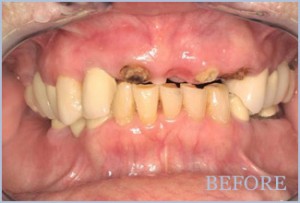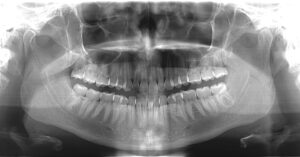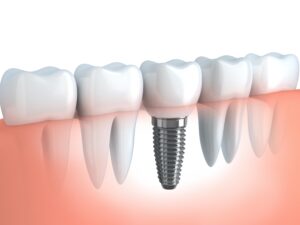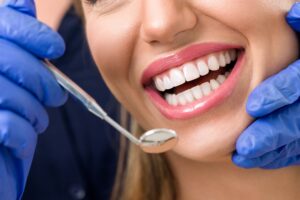Header logo
header top contact widget
Tooth Loss
Even OTC Pain Relievers Have Risks.
Posted on Dec 09, 2021 by William J. Claiborne, DDS MS
When we see new patients in our Asheville periodontal dental office, it’s common to hear comments about how the appointment was the most thorough they have ever experienced. We pride ourselves on our dental hygienists’ skills for dental cleanings, exams of gum tissues, and in advising patients of ways to maintain good oral health at home.
As a periodontal specialist, I perform a thorough examination of the teeth and oral tissues, both visually and through digital imaging (x-rays). In some cases, we use Cone Beam 3D imaging. Our goal is to have an in-depth view of each patient’s oral anatomy and intricate areas that can reveal problems, both potential and existing.
Our hygienists also work to consider the patient’s whole health so we can tailor their treatment to unique needs. They typically begin by noting any medications the patient takes, both over-the-counter or prescription. Herbal supplements taken regularly are also noted. Why?
The number of American adults who regularly use medications for pain relief has significantly expanded. For most mild to moderate pain, preferences for non-prescription pain relievers (analgesics) now lean towards non-steroidal anti-inflammatory drugs (NSAIDs) or acetaminophen.
There are a wide variety available over-the-counter (OTC), which means they are readily available without a prescription. Because these can be purchased right off the shelf, many people assume these medications are safe.
What consumers often miss, however, is the fact that many of these can have side effects. They can also interact with other medicines, dietary supplements, and alcohol consumption. Because pain medications contain the same ingredients found in a number of prescription drugs, adults may actually be taking a risky dose when combining medications.
According to a report from NBC News, Americans are taking too much of over-the-counter pain relief meds. In a study conducted by a Boston University School of Health researcher, nearly one in five users of popular headache remedies like Advil or Aleve admitted exceeding the recommended daily maximum dose during a one-week period.
Due to the side effects and without medical oversight, this can lead to higher risk for serious health problems, including gastrointestinal bleeding and heart attacks.
Before taking these meds, it’s important to get to know the types of pain medications (also known as analgesics) and how they work.
NSAIDs are an acronym for non-steroidal anti-inflammatory drugs. In this category are pain relievers that include aspirin, ibuprofen (Advil, Motrin), and naproxen sodium (Aleve, Naprosyn), and ketoprofen (Orudis).
Non-steroidal anti-inflammatory drugs reduce pain and inflammation by inhibiting production of prostaglandins, which are the hormone-like substances that cause them. Unfortunately, NSAIDs also block other prostaglandins that protect the stomach lining, regulate blood flow to the kidneys, and support blood clotting.
This is bad news for people who are regular users of NSAIDs or those who take high doses since they increase the potential for stomach inflammation, peptic ulcers, and intestinal bleeding. This is especially true for older adults. Taking NSAIDs in high doses or for an extended time can increase this risk even more.
An alternative is acetaminophen (Tylenol, Anacin-3, etc.), which relieves pain by affecting the areas of the brain that receive pain signals. Acetaminophen is best when the need is to reduce pain and fever, but is essentially ineffective in calming inflammation. The up side, however, is it will not cause the bleeding or clotting problems that have been associated with NSAIDs.
Yet, just as NSAIDs have a down side, so does acetaminophen. This analgesic is metabolized by enzymes in the liver. Taking too much can lead to liver damage in susceptible people, such as those who drink alcohol regularly. This is why it is important to read the labels of any medication so you don’t exceed the maximum daily dose of acetaminophen.
For most, taking non-prescription pain relievers – as directed on the label – is generally safe. The potential for trouble arises when you combine the following:
• Some NSAID and acetaminophen products, as well as cold, sinus, and allergy remedies, contain a blend of pain relievers. Kidney damage can result from extended use of painkillers that combine analgesics from different sources.
• A wide number of prescribed painkillers contain acetaminophen, such as Darvocet and Vicodin. Some prescriptions contain NSAIDS, including Celebrex and Percodan. Before you combine prescription medications with over-the-counter painkillers, be sure to check with your prescribing doctor first.
• NSAIDs can interact with other drugs, especially ACE inhibitors, anticoagulants, beta blockers, lithium, and methotrexate. Aspirin interacts with anticonvulsants, corticosteroids, insulin, and sulfa antibiotics. If you take any of these prescription medicines, check before using NSAIDs or aspirin.
• People are often surprised to learn that some herbal supplements, including garlic, ginger, feverfew, ginkgo, and ginseng, can thin blood. You should avoid taking these supplements while taking NSAIDs. When having procedures that may involve bleeding gums, these supplements, or combining them with NSAIDs, can complicate your procedure and the healing process.
One of the reasons we request updates on the medications you take at each visit is to provide you with optimal care. We want your oral health to support your overall health, and vice versa. Be a careful consumer of the medications you take, whether OTC or prescribed.
If you have questions, call 828-274-9440. You may want to begin with a free consultation to get to know us, or schedule complete periodontal examination, especially if you have signs or symptoms of periodontal (gum) disease. These include:
• Sore, tender gums that bleed easily while brushing teeth
• Frequent bad breath
• Gums that recede from the base of teeth, exposing darker, more sensitive sections of the tooth’s root
• Gums that are swollen
• Gum tissues that darken to more of a red color versus a healthy pink
If these signs exist, it is important to seek a periodontal evaluation as soon as possible. Gum disease will only worsen without treatment and is the nation’s leading cause of adult tooth loss.
At Biltmore Periodontics in Asheville, we are always happy to see new patients. A referral is not always needed.
Dental Fear Can Lead To Gum Disease, Tooth Loss
Posted on Nov 23, 2021 by William J. Claiborne, DDS MS
Fear is a natural reaction to things that may harm us; it’s a safety mechanism activated by the brain. Take snakes, for instance. Even harmless snakes tend to provoke an initial reaction that warns of impending danger.
Some fears are learned, however. Some people are afraid of dogs, usually stemming from a frightful encounter as children. The incident triggers something in the brain that reminds the individual, even into adulthood, that dogs are to be feared.
When it comes to the fear of dentistry, it often exists because of a traumatic incident in the patient’s past. Or, in some cases, it exists for unknown reasons. Too, certain smells, sounds or sights can trigger the “panicky” reaction some people have to dental visits.
As a periodontist in Asheville, I have a firsthand view of just what dental fear can do to oral health. Avoiding regular dental care is a sure recipe for cavities, periodontal (gum) disease, and eventual tooth loss.
Typically, adults who avoid dental visits feel they are doing an adequate job maintaining their oral wellness at home. In some minds, “I brush twice a day,” can be the justification to bypass recommended 6-month dental check-ups and cleanings.
Yet, even the best of at-home dental hygiene can be insufficient to the buildup of tartar.
Tartar is the hardened form of plaque, which is a sticky film of bacteria that accumulates in the mouth. In the form of tartar, this cement-hard mass of bacteria cannot be brushed or flossed away. It can only be removed by a dentist or hygienist using special tools.
While plaque can cause bad breath and a “furry” feeling mouth, tartar eats away at tender gum tissues and bores into tooth enamel. As it grows, it works its way below the gum line, creating inflammation in the gum tissues.
Early symptoms of gum disease, known as gingivitis, are tender or swollen gums. You may see blood in the sink when brushing teeth. Breath odor may be bad on a regular basis.
At this point, proper measures may be able to reverse the progression of these rapidly-reproducing bacteria. This requires thorough brushing (twice a day, at the very least), daily flossing, drinking lots of plain water, and using an oral rinse to control bacteria levels.
However, if tartar exists, it’s not going to go away. It will continue to amass and attack the gums and work its way into the tissues below. When the bacteria reach an uncontrollable level, they become infectious.
Think of gum disease bacteria as you would water in a pan on the stove. The heat will eventually cause bubbles to form on the bottom of the pan. This can be likened to gingivitis.
However, as the water heats more, bubbles start to move to the surface. This can symbolize the development of gum disease. The symptoms of gum disease include gums that turn red and bleed easily and persistent bad breath.
When advanced stage periodontal disease develops (periodontitis), imagine the water at full boil. Unfortunately, once aboil, the roil continues even after you remove the pan from the heat. This is known as systemic inflammation.

Gum disease is the nation’s leading cause of adult tooth loss. Yet, the bacteria that destroy gums and the structures that support natural teeth don’t remain confined to the mouth. Through tears in diseased gum tissues, these infectious bacteria can enter the bloodstream.
Research has correlated oral bacteria to a long list of serious health problems. Some can be activated by the bacteria of periodontitis, some are worsened. These include heart disease, stroke, Alzheimer’s disease, arthritis, diabetes, preterm babies, erectile dysfunction (ED), some cancers (including pancreatic), and more.
Obviously, these bacteria are potent and a threat to overall health. For those who avoid dental care due to anxiety or fear, knowing all this is not necessarily going to change their resistance. We understand that it’s still difficult to overcome the challenges even knowing there are risks.
There are options, however, for even high fear dental patients.
In our office, we offer I.V. sedation (“twilight sleep”) as well as oral sedation. Oral sedation is in pill form and creates a totally relaxed feeling. It enables patients to recover quickly and offers an amnesiac effect.
I.V. sedation is a deeper level of sedative. This places patients in a sleep state and erases most or all memory of the procedure after. With both sedations, however, we apply numbing medications to the area being treated to create optimal comfort for patients. We want patients to be in total comfort throughout their treatment, regardless of the addition of sedation.
We also have a reputation for treating our patients with respect and a gentle touch. We are just as committed to comfort for patients who do not want to be sedated as we are for those who are. Our goal is to help each person achieve a healthy, confident smile.
One of the most satisfying parts of my specialty is helping a once-fearful patient achieve a healthy, confident smile and see dental care as a welcomed part of their health care commitment.
If you are ready to get past your dental fears so you can have the smile you desire, begin by calling our Asheville periodontal office at: 828-274-9440 and speaking with our friendly staff. You can begin with a consultation, if desired.
Replace Teeth With Dental Implants Makes Good Sense
Posted on Nov 16, 2021 by William J. Claiborne, DDS MS
There’s a reason your general dentist is so determined to help you keep your natural teeth. When he or she recommends a crown (‘cap’) on a tooth to prevent potential removal (at the time or in the future), it is because a lost tooth is problematic in many ways.
First, the portions of teeth you see above the gum line stay in stable position because of the roots that hold it. Tooth roots (think “legs”) are supported by the upper or lower jaw bone. Larger teeth may have four roots. Some of the smaller teeth have only one.
These roots are beneficial to the health of the jaw bones. Tooth roots are connected to the jaw bone by veins and nerves that run from the tooth’s interior and out the bottom of each root leg. These vessels carry blood to the bone while providing a sort of stimulation that helps the bone to maintain its mass.
Think of the stimulation that tooth roots provide to how you might muscle atrophy. We all know that muscles, not used, will shrink in mass. When the jaw bones are lacking stimulation by the tooth roots they’re designed to hold, bone mass begins to decline.
Bone loss is the reason for a long line of problems. When bone loss occurs next to an area where natural teeth are held, those teeth are most likely to be the next to be lost.
When bone loss begins, it accelerates with each passing year. And eventually, a shrinking jaw bone reveals itself in changes in facial appearance. Initially, there may be deep wrinkling around the mouth. The corners of the mouth turn downward. Jowls form and the chin becomes more pointed.
As bone loss becomes more severe, the mouth seems to sink into the face. The nose and chin get closer, giving a “granny look”. The thin jaw bone is also more vulnerable to breaks.
Bone loss is what causes a change in how partials and dentures fit. As the bone height declines, the denture or partial becomes less secure from the declining bone shape to which it was designed to fit. More-frequent applications of pastes and adhesives are needed. Relines help but only temporarily.
Teeth also serve to support neighboring teeth. Each tooth keeps the ones on either side and above (or below) in proper position. This supports the “bite” alignment. A misaligned bite (how upper teeth fit and interact with lower teeth) can result in teeth that become chipped, worn or fractured.
Bite misalignment can also lead to TMJ disorder. The TMJ are your jaw joints, which hinge the lower jaw to the skull. When a misaligned bite causes stress or strain on these joints, the result can be headaches, sore jaw joints, ear ringing, vertigo, difficulty opening the mouth fully, and sore muscles in the face, neck and shoulders.
The reason we advise replacing teeth with dental implants are many:
1). A dental implant recreates the presence of a natural tooth. It provides stimulation to the bone, halting the process of bone loss.
2). Dental implants do not rely on neighboring teeth for support, as in a crown-&-bridge combination. The crowning of bordering natural teeth to support a bridge is not needed. Thus, the integrity of surrounding teeth is protected.
3). Because dental implants are supported by the jaw bone, sturdy and dependable biting and chewing strength is restored. Eating a healthy diet of all the foods you love is again possible.
4). Dental implants come in many sizes and shapes, each system designed to accommodate various needs and preferences. This means your implant can be chosen to suit your long-term goals.
5). Dental implants have an extremely high success rate, higher than any implant-in-bone option.
6). Dental implants are designed to last a lifetime. With proper selection and maintenance, they will never need replacing or repair. This makes them an excellent investment.
A periodontist is a dental specialist who is skilled offers an advanced understanding when it comes to oral tissues as well as dental implants. The advantages of a periodontist in dental implant selection and placement are many.
A periodontal specialist is trained to understand the intricate concepts involved in selecting the proper type of implant and skilled at placing implants at proper depths and angles. A periodontist is also able to optimize patient comfort during treatment and throughout the healing phase.
Using his or her advanced training in the diagnosis and placement of dental implants, a periodontist can help you enjoy a higher potential for dental implant treatment that lasts a lifetime.
In our Asheville periodontal dental office, we offer some of the most advanced technology available. This technology, combined with our advanced skill level, can help you enjoy a comfortable, efficient experience that allows you to have optimal success.
To learn more, call our office at: 828-274-9440 to request a consultation. Or, begin with an initial periodontal examination.
What’s Keeping You From The Dentist’s Office?
Posted on Oct 19, 2021 by William J. Claiborne, DDS MS
As an Periodontist in Asheville NC, I’ve treated many patients who, to no surprise, developed periodontal (gum) disease because of NOT going to a dentist on a regular basis.
According to the Centers for Disease Control & Prevention (CDC), nearly 65 percent of adults aged 18 and over had at least one dental visit in the past year (based on 2019).
https://www.cdc.gov/nchs/fastats/dental.htm
Unfortunately, that leaves 35 percent of adults who did not. 
The reason it is recommended to see a dentist for exams and cleanings TWICE A YEAR is because tartar, which is hardened plaque, can cause cavities and gum disease. One plaque hardens into tartar, it can no longer be brushed or flossed away. It must be removed by a dentist or hygienist using special tools.
Tartar is actually a mass of oral bacteria, which has attached itself to the base of (or in-between) teeth. Tartar (also referred to as calculus), is a colony of bacteria that thrive on oral tissues. Bacteria are living organisms and reproduce rapidly. And, the more there are, the more rapidly they amass.
So, what are the common excuses for avoiding regular dental care? See if you’ve been guilty of one or more:
COST – Some individuals feel dental cleanings and exams are expensive. Actually, there is a great deal of time and training that goes into your individualized care. In addition to the measures of sterilization and instruments, hygienists and dentists are highly-trained, educated, and must stay board certified. As for the investment, these visits are what help you avoid the need for a filling, gum disease, potential damage to teeth due to bite misalignment, and even catch oral cancer at early stages. If dental insurance is not possible, ask if payment plans are available. Many dental offices offer these, most of which are interest-free with no down payment required.
DENTAL FEAR – If fear or anxiety keeps you away from a dental chair, you are not alone. It is estimated that over 70 percent of American adults have some level of this. Sometimes the fear exists because of a traumatic experience in the past or feeling helpless in the chair. Some people react to certain smells and sounds. A few have no idea what prompted their fear, but know it is beyond their control. For these, we advise seeking dental care in a modernized office. Today’s advanced technology has greatly enhanced the level of comfort during care as well as reduced treatment time. Too, offices such as our Asheville periodontal dental office offer oral sedation as well as IV sedation (twilight sleep). These are administered by highly-skilled professionals who oversee the patient using advanced safety monitoring equipment. Ask for a consultation and tour before choosing the office that is reassuring to your unique needs.
DREAD OF BEING LECTURED – If it’s been years since you’ve seen a dentist, you may be expecting a lecture from the dentist or hygienist (or both!). My staff and I believe that is a sure way to deter someone from cultivating a positive attitude towards their dental relationship. We all want to feel respected and having a caregiver talk “down” to you is unfair, especially because no one knows the story behind your delay or avoidance. If you feel that’s going to be a problem, say so. Be upfront with “a lecture is not going to help me.” If you feel it’s a recurring problem, ask to have your records transferred to an office where you are treated more appropriately.
FEAR OF EMBARRASSMENT – Some adults feel awkward having their denture or partial removed at the dentist’s office. Some people fear they’ll gag during care, which can trigger coughing and even throwing up. Some feel their mouths are so “bombed out” that it’s embarrassing to have a dentist see how much damage has occurred. To reassure you, there is nothing we haven’t seen or experienced. Dentists have quite a lot thrown at us during dental school. As a specialist in periodontics, my additional training covered even more in-depth and complex damage or disease. DO NOT worry about your caregivers. They WANT you to rely on them to help you. Almost any dentist or specialist will tell you that our greatest joy comes from taking a patient from a “hopeless” mouth to a patient who has a healthy, confident smile!
TIME IN TREATMENT – Today’s advanced technology has greatly condensed the time needed to accurately diagnose and treatment plan almost any dental problem. Many treatments can be completed in just one or two visits. For those who have more extensive needs, dentists can sometimes combine several appointments into one long one. This is made much easier for the patient with the addition of oral sedation. Oral sedation creates a totally relaxed state so the patient can “doze” in and out of treatment. It has a quick recovery and sedated patients are carefully monitored for safety and comfort throughout treatment.
Regardless of WHY you’ve avoided the dentist, your smile is worth it! Having an appealing smile you feel joyful in sharing adds to your mood, enhances appearance and makes a positive impression to others.
If you’ve avoided dental care for years (or even decades), you may have signs or symptoms of periodontal disease. These include tender gums that may bleed when brushing, gums that recede from the base of some teeth, gums that turn red in color, and frequent bad breath. Gums are the foundation for teeth, so without healthy gums, your teeth will not be healthy, either.
Too, gum disease will only worsen without treatment. If you are a reader of my articles, you may have read the findings of research that correlates the bacteria of gum disease with serious health conditions. These include stroke, heart disease, preterm babies, some cancers, arthritis, diabetes, and erectile dysfunction.
Let us help you feel the positive aspects of achieving a healthy smile. Begin with a consultation by calling 828-274-9440.
Recent Posts
Categories
Archives
- September 2024
- August 2024
- July 2024
- June 2024
- May 2024
- April 2024
- March 2024
- February 2024
- January 2024
- December 2023
- November 2023
- October 2023
- September 2023
- August 2023
- July 2023
- June 2023
- May 2023
- April 2023
- March 2023
- February 2023
- January 2023
- December 2022
- November 2022
- October 2022
- September 2022
- August 2022
- July 2022
- June 2022
- May 2022
- April 2022
- March 2022
- February 2022
- January 2022
- December 2021
- November 2021
- October 2021
- September 2021
- August 2021
- July 2021
- June 2021
- May 2021
- April 2021
- March 2021
- February 2021
- January 2021
- December 2020
- November 2020
- October 2020
- September 2020
- August 2020
- July 2020
- June 2020
- May 2020
- April 2020
- March 2020
- February 2020
- January 2020
- December 2019
- November 2019
- October 2019
- September 2019
- August 2019
- July 2019
- June 2019
- May 2019
- April 2019
- March 2019
- February 2019
- January 2019
- December 2018
- November 2018
- October 2018
- September 2018
- August 2018
- July 2018
- June 2018
- May 2018
- April 2018
- March 2018
- February 2018
- January 2018
- December 2017
- November 2017
- October 2017
- September 2017
- August 2017
- July 2017
- June 2017
- May 2017
- April 2017
- March 2017
- February 2017
- January 2017
- December 2016
- November 2016
- October 2016
- September 2016
- August 2016
- July 2016
- June 2016
- May 2016
- April 2016
- March 2016
- February 2016
- January 2016
- December 2015
- November 2015
- October 2015
- September 2015
- August 2015
- July 2015
- June 2015
- May 2015
- April 2015
- March 2015
- February 2015
- January 2015
- December 2014
- November 2014
- October 2014
- September 2014
- August 2014
- July 2014
- June 2014
- May 2014
- April 2014
- March 2014
- February 2014
- January 2014
- December 2013
- November 2013
- October 2013
- September 2013
- August 2013
- July 2013
- June 2013
- May 2013
- April 2013
- March 2013
- February 2013
- January 2013
- December 2012
- November 2012
- October 2012
- September 2012
- August 2012
- July 2012
- June 2012


